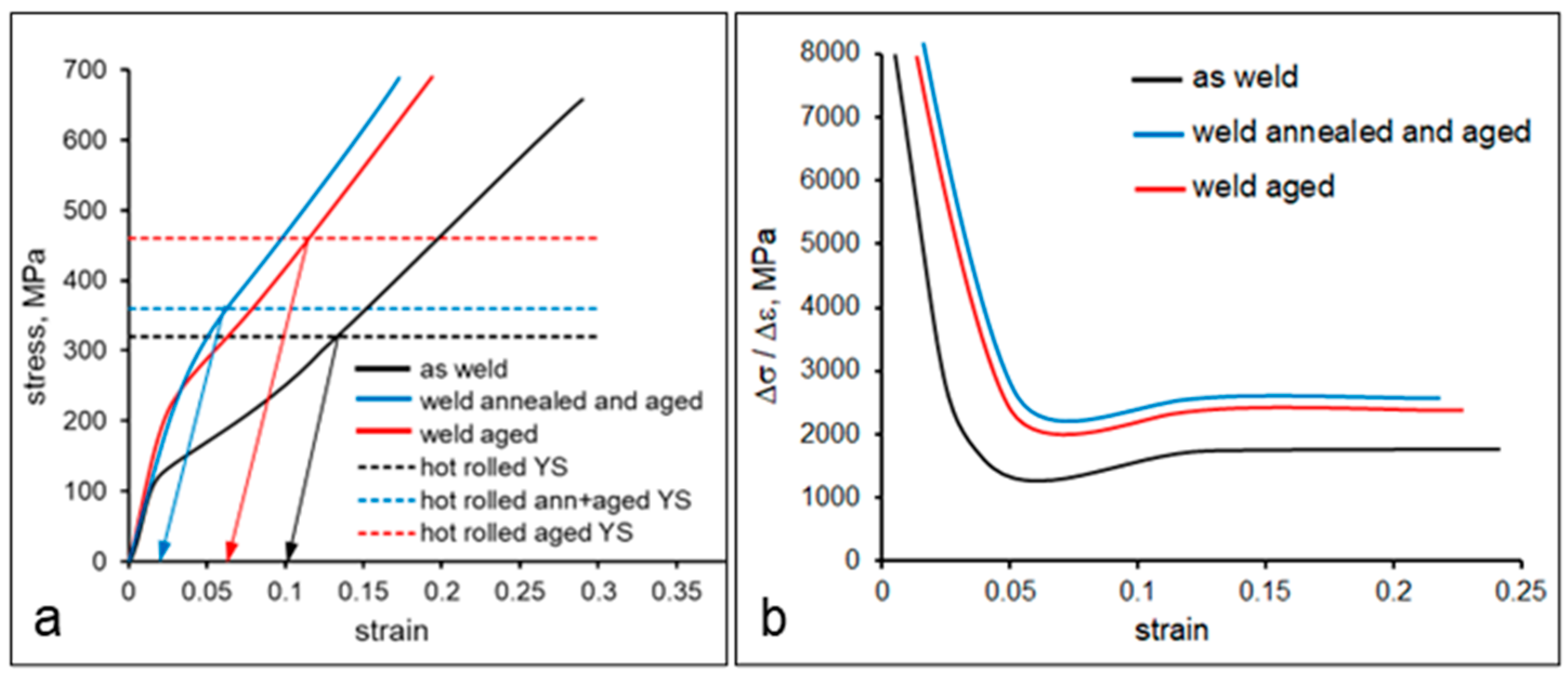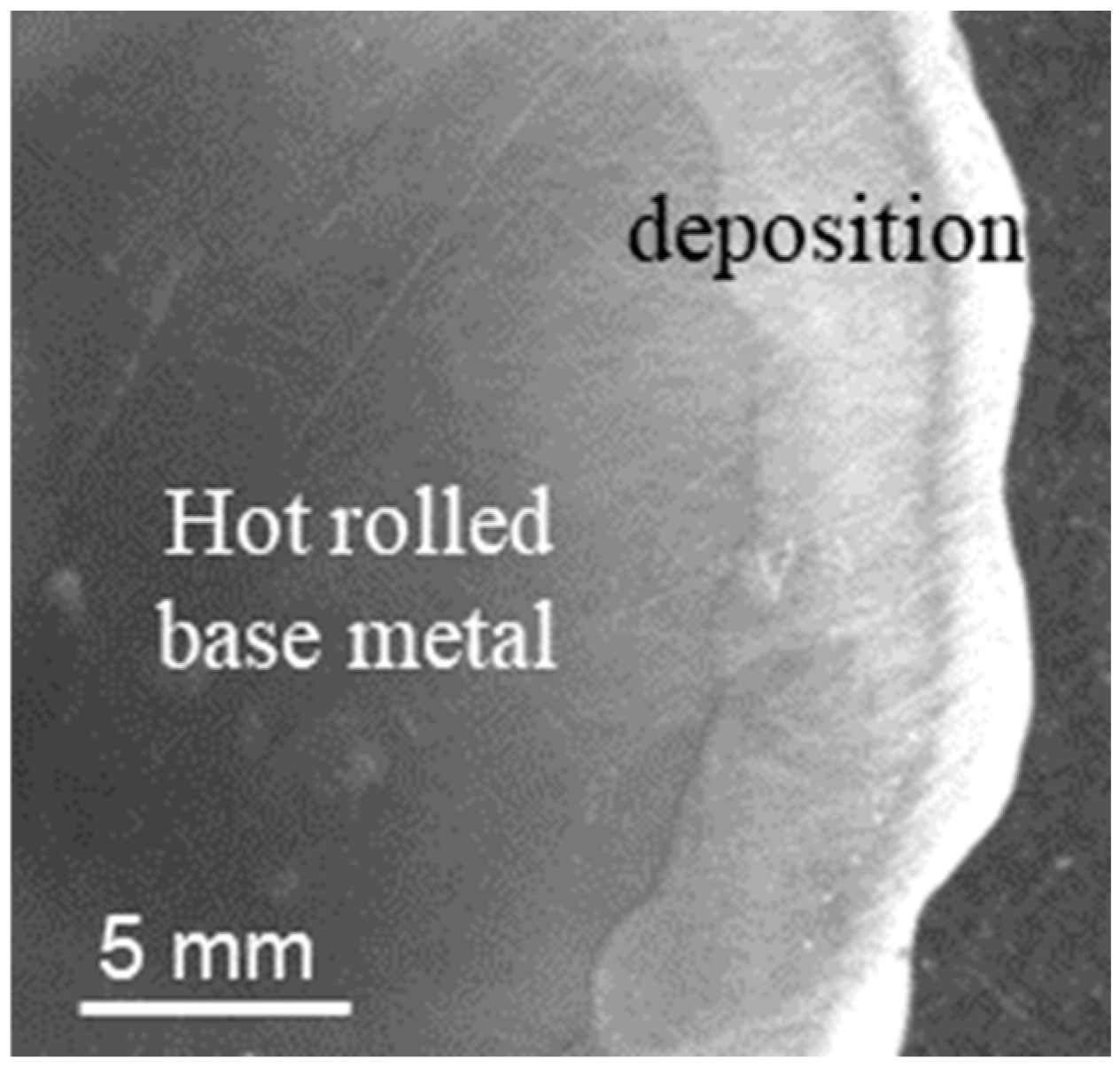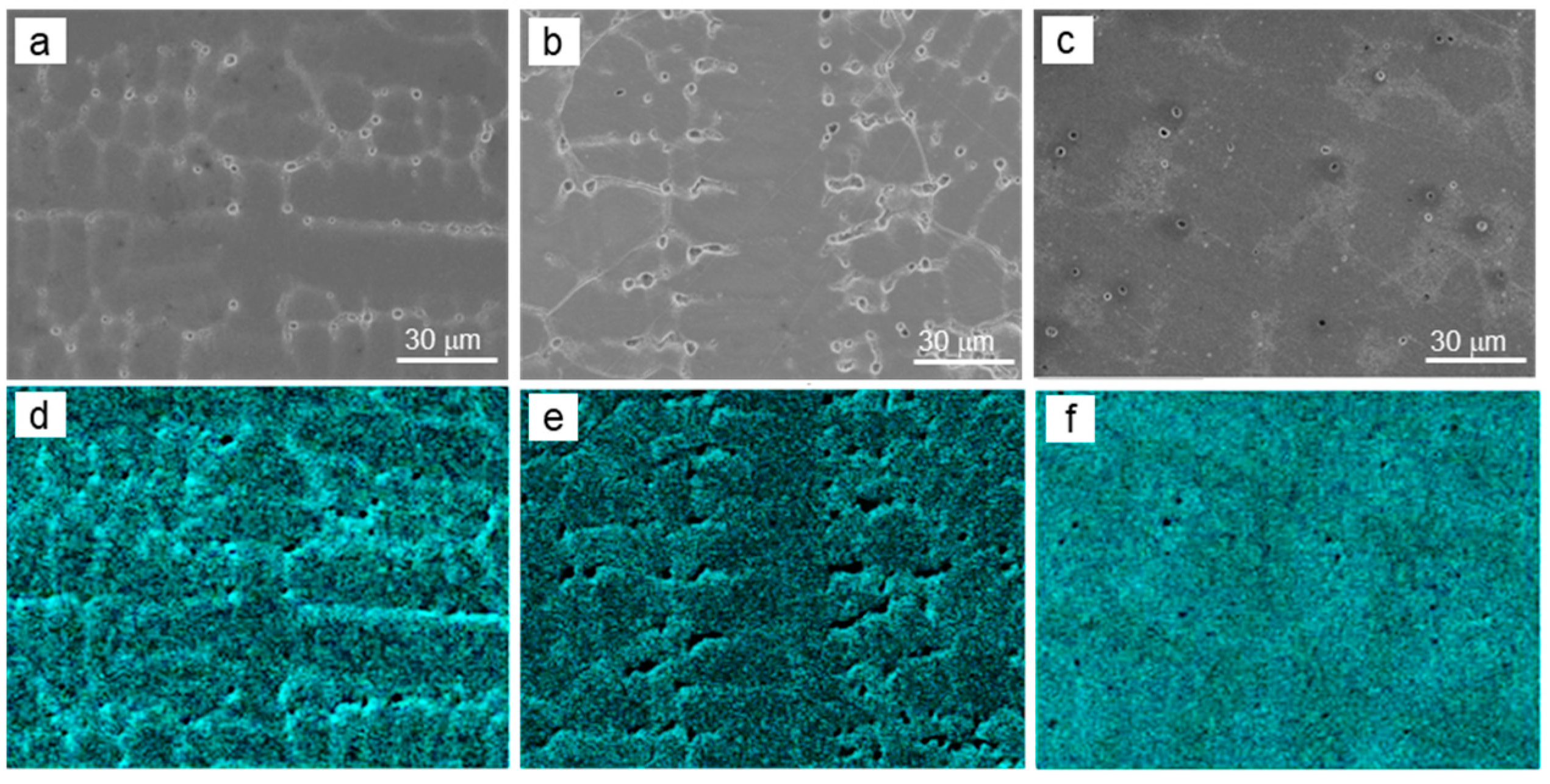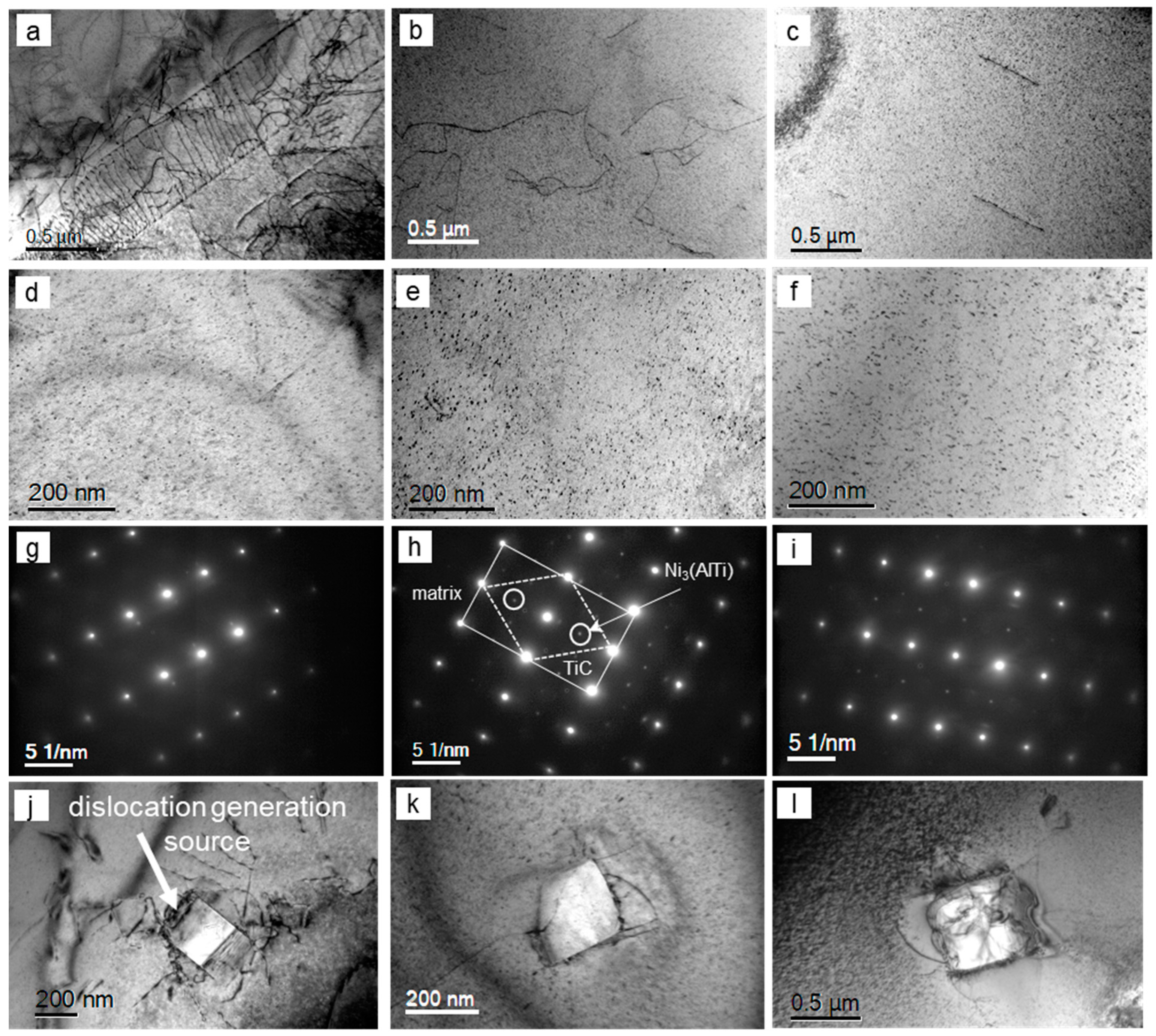A Comparative Analysis of a Microstructure and Properties for Monel K500 Hot-Rolled to a Round Bar and Wire Deposited on a Round Surface
Abstract
1. Introduction
2. Materials and Experimental Techniques
3. Results
3.1. Hardness and Strength
- In the range of 140–170 HV (the difference between maximum and minimum Δ = 30) with the average value of 153 HV in the as-welded condition;
- In the range of 230–316 HV (Δ = 86) with the average value of 263 HV in the aged condition;
- In the range of 203–275 HV (Δ = 72) with the average value of 238 HV in the annealed and aged condition; and this in the hot-rolled rod was measured to be
- In the range of 175–206 HV (Δ = 31) with the average value of 191 HV in the as-received condition;
- In the range of 274–294 HV (Δ = 20) with the average value of 285 HV in the aged condition;
- In the range of 269–294 HV (Δ = 25) with the average value of 276 HV in the annealed and aged condition.


- 120 ± 10 MPa in the as-welded condition;
- 220 ± 14 MPa in the aged condition;
- 200 ± 12 MPa in the annealed and aged condition; and this in the hot-rolled rod was measured to be
- 320 ± 10 MPa in the as-received hot-rolled condition;
- 470 ± 15 MPa in the aged condition;
- 360 ± 12 MPa after annealing followed by ageing.
3.2. Microstructure Characterisation
- The secondary dendrite arm spacing in the weld-deposited alloy was smaller than the average grain size (distance between the high angle boundaries) in the hot-rolled condition; this could be related to a relatively fast cooling rate during the solidification of the small weld pool and multiple cycles of recrystallisation and grain growth taking place during hot rolling.
- Grain coarsening followed the annealing and ageing in both material conditions.
- The average size of coarse particles decreased and the particle number density increased in the hot-rolled alloy after annealing and ageing; this was an opposite trend to the weld deposition. This could be explained if the particle reprecipitation process during ageing prevailed over their dissolution during annealing in the deformed microstructure. The reason for this might be a 10 times higher dislocation density in the hot-rolled alloy facilitating nucleation on dislocations.
- The number density of fine particles similarly increased for both alloy conditions during ageing, although to a greater extent in the deformed alloy (from 5422 to 9794 μm−3 in weld deposition against that from 8920 to 11,000 μm−3 in the deformed one).
- However, after annealing and ageing, the fine particle number density decreased in the hot-rolled alloy and increased in the weld-deposited one; this could follow a larger matrix depletion in Ti and Al in the hot-rolled alloy due to a faster growth of the coarse particles.
- The dislocation density decreased in both alloy conditions with heat treatment, however, to a lesser extent in the hot-rolled alloy (3 times in the hot-rolled one compared to 5 times in the weld-deposited one for the annealed and aged condition), leading to almost 10 times variation in the dislocation density in the hot-rolled and weld-deposited alloys; this could be related to a slower dislocation annihilation process in the deformed microstructure due to multiple dislocation tangles that slow down the dislocation motion [66,67].
4. Discussion
5. Conclusions
- In the hot-rolled alloy, the average hardness was 20–40 HV higher and the yield stress was 1.8–2.6 times higher than these in the weld deposition (depending on heat treatment). Higher strength of the hot-rolled alloy was associated with up to 60% higher precipitate number density and up to 10 times higher dislocation density.
- In both material conditions (rolled and WAAM-processed), the hardness and compression yield stress increased after ageing without prior annealing to a greater extent than this after ageing following annealing. This can be explained by two major microstructural transformations taking place during annealing: grain growth—decreases the grain boundary strengthening; and dislocation annihilation—decreases the dislocation strengthening and the number of particle nucleation sites during ageing, leading to a decreased particle number density and precipitation strengthening effect.
- The hardness inhomogeneity (a variation between the largest and smallest values) was of a similar level in the WAAM-processed alloy as in the hot-rolled one. However, age hardening heat treatment resulted in the hardness inhomogeneity increase in the WAAM alloy and a decrease in the hot-rolled one. This corresponds to the chemical inhomogeneity of the WAAM alloy, namely the presence of Cu-rich and Cu-poor areas and zones of increased number density of TiCN particles. Chemical inhomogeneity may originate from the elements’ segregation during the weld pool solidification over a relatively short period of time.
- Coarse > 200 nm particles were shown to act as dislocation generation sources, leading to an increase in the work hardening rate. Due to the high work hardening rate, minor cold deformation (0.03–0.10 strain depending on prior heat treatment) was required to equalise the yield stress values for the WAAM alloy to these of the hot-rolled one.
- On the bases of the obtained results, a new technology was proposed, which includes wire arc additive manufacturing followed by heat treatment in the 610–1100 °C temperature range and cold deformation to 0.15 strain. This technology is expected to produce Monel K500 alloy components with hardness and strength similar to these in the hot-rolled products.
Author Contributions
Funding
Institutional Review Board Statement
Data Availability Statement
Acknowledgments
Conflicts of Interest
References
- Wang, F.; Williams, S.; Rush, M. Morphology investigation on direct current pulsed gas tungsten arc welded additive layer manufactured Ti6Al4V alloy. Int. J. Adv. Manuf. Technol. 2011, 57, 597–603. [Google Scholar] [CrossRef]
- Wu, B.; Ding, D.; Pan, Z.; Cuiuri, D.; Li, H.; Han, J.; Fei, Z. Effects of heat accumulation on the arc characteristics and metal transfer behavior in Wire Arc Additive Manufacturing of Ti6Al4V. J. Mater. Process. Technol. 2017, 250, 304–312. [Google Scholar] [CrossRef]
- Davis, A.E.; Breheny, C.I.; Fellowes, J.; Nwankpa, U.; Martina, F.; Ding, J.; Machry, T.; Prangnell, P.B. Mechanical performance and microstructural characterisation of titanium alloy-alloy composites built by wire-arc additive manufacture. Mater. Sci. Eng. A 2019, 765, 138289. [Google Scholar] [CrossRef]
- Lin, Z.; Song, K.; Yu, X. A review on wire and arc additive manufacturing of titanium alloy. J. Manuf. Processes 2021, 70, 24–45. [Google Scholar] [CrossRef]
- Haden, C.V.; Zeng, G.; Carter, F.M., III; Ruhl, C.; Krick, B.A.; Harlow, D.G. Wire and arc additive manufactured steel: Tensile and wear properties. Addit. Manuf. 2017, 16, 115–123. [Google Scholar] [CrossRef]
- Shen, C.; Pan, Z.; Cuiuri, D.; Ding, D.; Li, H. Influences of deposition current and interpass temperature to the Fe3Al-based iron aluminide fabricated using wire-arc additive manufacturing process. Int. J. Adv. Manuf. Technol. 2017, 88, 2009–2018. [Google Scholar] [CrossRef]
- Wang, L.; Xue, J.; Wang, Q. Correlation between arc mode, microstructure, and mechanical properties during wire arc additive manufacturing of 316L stainless steel. Mater. Sci. Eng. A 2019, 751, 183–190. [Google Scholar] [CrossRef]
- Rodrigues, T.A.; Duarte, V.R.; Tomás, D.; Avila, J.A.; Escobar, J.D.; Rossinyol, E.; Schell, N.; Santos, T.G.; Oliveira, J.P. In-situ strengthening of a high strength low alloy steel during Wire and Arc Additive Manufacturing (WAAM). Addit. Manuf. 2020, 34, 101200. [Google Scholar] [CrossRef]
- Cong, B.; Ding, J.; Williams, S. Effect of arc mode in cold metal transfer process on porosity of additively manufactured Al-6.3%Cu alloy. Int. J. Adv. Manuf. Technol. 2015, 76, 1593–1606. [Google Scholar] [CrossRef]
- Gu, J.; Wang, X.; Bai, J.; Ding, J.; Williams, S.; Zhai, Y.; Liu, K. Deformation microstructures and strengthening mechanisms for the wire + arc additively manufactured Al-Mg4.5Mn alloy with inter-layer rolling. Mater. Sci. Eng. A 2018, 712, 292–301. [Google Scholar] [CrossRef]
- Qi, Z.; Cong, B.; Qi, B.; Sun, H.; Zhao, G.; Ding, J. Microstructure and mechanical properties of double-wire+arc additively manufactured Al-Cu-Mg alloys. J. Mater. Process. Technol. 2018, 255, 347–353. [Google Scholar] [CrossRef]
- Klein, T.; Reiter, L.; Schnall, M. Wire-arc additive manufacturing of Al-Zn5.5-Mg-Cu (ML7075): Shifting paradigms of additive manufacture-ability. Mater. Lett. 2022, 313, 131841. [Google Scholar] [CrossRef]
- Ding, D.; Pan, Z.; van Duin, S.; Li, H.; Shen, C. Fabricating Superior NiAl Bronze Components through Wire Arc Additive Manufacturing. Materials 2016, 9, 652. [Google Scholar] [CrossRef] [PubMed]
- Zhang, H.; Hu, S.; Wang, Z.; Liang, Y. The effect of welding speed on microstructures of cold metal transfer deposited AZ31 magnesium alloy clad. Mater. Des. 2015, 86, 894–901. [Google Scholar] [CrossRef]
- Li, J.; Qiu, Y.; Yang, J.; Sheng, Y.; Yi, Y.; Zeng, X.; Chen, L.; Yin, F.; Su, J.; Zhang, T.; et al. Effect of grain refinement induced by wire and arc additive manufacture (WAAM) on the corrosion behaviors of AZ31 magnesium alloy in NaCl solution. J. Magnes. Alloys 2023, 11, 217–229. [Google Scholar] [CrossRef]
- Baufeld, B. Mechanical Properties of Inconel 718 Parts Manufactured by Shaped Metal Deposition (SMD). J. Mater. Eng. Perform. 2012, 21, 1416–1421. [Google Scholar] [CrossRef]
- Xu, F.J.; Lv, Y.H.; Xu, B.S.; Liu, Y.X.; Shu, F.Y.; He, P. Effect of deposition strategy on the microstructure and mechanical properties of Inconel 625 superalloy fabricated by pulsed plasma arc deposition. Mater. Des. 2013, 45, 446–455. [Google Scholar] [CrossRef]
- James, W.S.; Ganguly, S.; Pardal, G. High temperature performance of wire-arc additive manufactured Inconel 718. Sci. Rep. 2023, 13, 4541. [Google Scholar] [CrossRef]
- Wang, J.; Pan, Z.; Carpenter, K.; Han, J.; Wang, Z.; Li, H. Comparative study on crystallographic orientation, precipitation, phase transformation and mechanical response of Ni-rich NiTi alloy fabricated by WAAM at elevated substrate heating temperatures. Mater. Sci. Eng. A 2021, 800, 140307. [Google Scholar] [CrossRef]
- Ke, W.C.; Oliveira, J.P.; Cong, B.Q.; Ao, S.S.; Qi, Z.W.; Peng, B.; Zeng, Z. Multi-layer deposition mechanism in ultra high-frequency pulsed wire arc additive manufacturing (WAAM) of NiTi shape memory alloys. Addit. Manuf. 2022, 50, 102513. [Google Scholar] [CrossRef]
- Marenych, O.O.; Ding, D.; Pan, Z.; Kostryzhev, A.G.; Li, H.; van Duin, S. Effect of chemical composition on microstructure, strength and wear resistance of wire deposited Ni-Cu alloys. Addit. Manuf. 2018, 24, 30–36. [Google Scholar] [CrossRef]
- Marenych, O.; Kostryzhev, A.; Shen, C.; Pan, Z.; Li, H.; van Duin, S. Precipitation strengthening in Ni–Cu alloys fabricated using wire arc additive manufacturing technology. Metals 2019, 9, 105. [Google Scholar] [CrossRef]
- Qi, F.; Fu, H.; Song, Y.; Yun, X. Regulation of dislocation density and precipitates to maximize the mechanical strength and electrical conductivity in continuously extruded Cu–Ni–Si alloys. J. Mater. Res. Technol. 2024, 30, 8519–8528. [Google Scholar] [CrossRef]
- Poddar, D.; Cizek, P.; Beladi, H.; Hodgson, P.D. Evolution of strain-induced precipitates in a model austenitic Fe–30Ni–Nb steel and their effect on the flow behaviour. Acta Mater. 2014, 80, 1–15. [Google Scholar] [CrossRef]
- Kostryzhev, A.G.; Mannan, P.; Marenych, O.O. High temperature dislocation structure and NbC precipitation in three Ni-Fe-Nb-C model alloys. J. Mater. Sci. 2015, 50, 7115–7125. [Google Scholar] [CrossRef]
- Marenych, O.; Kostryzhev, A. Strengthening mechanisms in Ni-Cu alloys: A review. Metals 2020, 10, 1358. [Google Scholar] [CrossRef]
- Mishra, D.; Vignesh, M.K.; Raj, B.G.; Srungavarapu, P.; Ramkumar, K.D.; Arivazhagan, N.; Narayanan, S. Mechanical characterization of Monel 400 and 316 stainless steel weldments. Procedia Eng. 2014, 75, 24–28. [Google Scholar] [CrossRef]
- Khandke, S.P.; Surve, A.; Patil, D.; Balan, A.S.S.; Kuppan, P.; Oyyaravelu, R. Grindability studies on monel under different cooling environments. Mater. Today Proc. 2018, 5, 12559–12569. [Google Scholar] [CrossRef]
- Devendranath, R.K.; Arivazhagan, N.; Narayanan, S.; Narayanan, M.; Mondody, A.; Kashyap, R. Development of defect free Monel 400 welds for marine application. Adv. Mater. Res. 2012, 383–390, 4693–4696. [Google Scholar] [CrossRef]
- Shoemaker, L.E.; Smith, G.D. A century of Monel metal: 1906–2006. JOM 2006, 58, 22–26. [Google Scholar] [CrossRef]
- Dutta, R.S. Corrosion aspects of Ni–Cr–Fe based and Ni–Cu based steam generator tube materials. J. Nucl. Mater. 2009, 393, 343–349. [Google Scholar] [CrossRef]
- Francis, J.T.; Brennenstu, A.M.; Ramamurthy, S.N.; Mcintyre, S. Use of ToF-SIMS in the study of corrosion processes: Monel 400 steam generator tubing under CANDU start-up conditions. Surf. Interface Anal. 2002, 34, 189–191. [Google Scholar] [CrossRef]
- Hodge, F.G. The history of solid-solution-strengthened Ni alloys for aqueous corrosion service. JOM 2006, 58, 28–30. [Google Scholar] [CrossRef]
- Gaines, R.H. Monel metal. J. Ind. Eng. Chem. 1912, 4, 354–358. [Google Scholar] [CrossRef][Green Version]
- Ganley, J.C. High temperature and pressure alkaline electrolysis. Int. J. Hydrogen Energy 2009, 34, 3604–3611. [Google Scholar] [CrossRef]
- Werner, T.C.; Yan, Y.; Mullen, D.; Halimic, E. Experimental analysis of a high temperature water heat pipe for thermal storage applications. Therm. Sci. Eng. Prog. 2020, 19, 100564. [Google Scholar] [CrossRef]
- Ghorbani, M.M.; Taherian, R.; Bozorg, M. Investigation on physical and electrochemical properties of TiN-coated Monel alloy used for bipolar plates of proton exchange membrane fuel cell. Mater. Chem. Phys. 2019, 238, 121916. [Google Scholar] [CrossRef]
- Solmaz, R.; Döner, A.; Kardas, G. The stability of hydrogen evolution activity and corrosion behavior of NiCu coatings with long-term electrolysis in alkaline solution. Int. J. Hydrogen Energy 2009, 34, 2089–2094. [Google Scholar] [CrossRef]
- Ahn, S.H.; Park, H.-Y.; Choi, I.; Yoo, S.J.; Hwang, S.J.; Kim, H.-J.; Cho, E.A.; Yoon, C.W.; Park, H.; Son, H.; et al. Electrochemically fabricated NiCu alloy catalysts for hydrogen production in alkaline water electrolysis. Int. J. Hydrogen Energy 2013, 38, 13493–13501. [Google Scholar] [CrossRef]
- Wang, K.; Xia, M.; Xiao, T.; Lei, T.; Yan, W. Metallurgically prepared NiCu alloys as cathode materials for hydrogen evolution reaction. Mater. Chem. Phys. 2017, 186, 61–66. [Google Scholar] [CrossRef]
- Ghosh, S.K.; Grover, A.K.; Dey, G.K.; Suri, A.K. Synthesis of corrosion-resistant nanocrystalline nickel–copper alloy coatings by pulse-plating technique. Def. Sci. J. 2005, 55, 63–74. [Google Scholar] [CrossRef]
- Geramipour, F.; Mousavi Khoei, S.M.; Shooshtari Gugtapeh, H. Effect of shaped waveform on structure and electrochemical corrosion behavior of pulse electrodeposited Ni–Cu alloy coatings. Surf. Coat. Technol. 2021, 424, 127643. [Google Scholar] [CrossRef]
- Rao, A.S.; Manda, P.; Mohan, M.K.; Nandy, T.K.; Singh, A.K. Microstructure, texture and mechanical properties of hot rolled and annealed Ni-Fe-W and Ni-Fe-W-Co matrix alloys. J. Alloys Compd. 2018, 742, 937–951. [Google Scholar]
- Song, Y.; Fan, J.; Liu, X.; Zhang, P.; Li, J. Thermal processing map and microstructure evolution of Inconel 625 alloy sheet based on plane strain compression deformation. Materials 2021, 14, 5059. [Google Scholar] [CrossRef]
- Yang, F.; Dong, L.; Hu, X.; Zhou, X.; Xie, Z.; Fang, F. Effect of solution treatment temperature upon the microstructure and mechanical properties of hot rolled Inconel 625 alloy. J. Mater. Sci. 2020, 55, 5613–5626. [Google Scholar] [CrossRef]
- Kannan, A.R.; Kumar, S.M.; Pramod, R.; Shanmugam, N.S.; Vishnukumar, M.; Channabasavanna, S.G. Microstructure and corrosion resistance of Ni-Cu alloy fabricated through wire arc additive manufacturing. Mater. Lett. 2022, 308, 131262. [Google Scholar] [CrossRef]
- Hu, D.; Loretto, M.H. Coarsening of TiC particles in a rapidly solidified Ti6A14V-TiC composite. J. Alloys Compd. 1994, 209, 167–173. [Google Scholar] [CrossRef]
- Gustafson, A. Coarsening of TiC in austenitic stainless steel–experiments and simulations in comparison. Mater. Sci. Eng. A 2000, 287, 52–58. [Google Scholar] [CrossRef]
- Jang, J.H.; Lee, C.-H.; Han, H.N.; Bhadeshia, H.K.D.H.; Suh, D.-W. Modelling coarsening behaviour of TiC precipitates in high strength, low alloy steels. Mater. Sci. Technol. 2013, 29, 1074–1079. [Google Scholar] [CrossRef]
- Solis-Bravo, G.; Merwin, M.; Garcia, C.I. Impact of precipitate morphology on the dissolution and grain-coarsening behavior of a Ti-Nb microalloyed linepipe steel. Metals 2020, 10, 89. [Google Scholar] [CrossRef]
- Marchese, G.; Aversa, A.; Bassini, E. Microstructure and hardness evolution of solution annealed Inconel 625/TiC composite processed by laser powder bed fusion. Metals 2021, 11, 929. [Google Scholar] [CrossRef]
- Shi, P.; Xu, W.; Fu, B.; Liu, J.; Zhang, J.; Wang, K.; Liu, X. Pore defects in a nickel-based superalloy with high Ti content. Prog. Nat. Sci. 2022, 32, 456–462. [Google Scholar] [CrossRef]
- Agudo-Jacome, L.; Nörtershäuser, P.; Heyer, J.-K.; Lahni, A.; Frenzel, J.; Dlouhy, A.; Somsen, C.; Eggeler, G. High-temperature and low-stress creep anisotropy of single-crystal superalloys. Acta Mater. 2013, 61, 2926–2943. [Google Scholar] [CrossRef]
- Nörtershäuser, P.; Frenzel, J.; Ludwig, A.; Neuking, K.; Eggeler, G. The effect of cast microstructure and crystallography on rafting, dislocation plasticity and creep anisotropy of single crystal Ni-base superalloys. Mater. Sci. Eng. A 2015, 626, 305–312. [Google Scholar] [CrossRef]
- Yamaguchi, I.; Yonemura, M. Recovery and recrystallization behaviors of Ni–30 Mass pct fe alloy during uniaxial cold and hot compression. Metall. Mater. Trans. A 2021, 52, 3517–3529. [Google Scholar] [CrossRef]
- Joseph, A.S.; Gupta, P.; Kumar, N.; Poletti, M.C.; Yadav, S.D. An advanced dislocation density-based approach to model the tensile flow behaviour of a 64.7Ni–31.96Cu alloy. Philos. Mag. 2022, 102, 1481–1504. [Google Scholar] [CrossRef]
- Zhou, G.; Pantleon, W.; Xu, R.; Liu, W.; Chen, K.; Zhang, Y. Quantification of local dislocation density using 3D synchrotron monochromatic X-ray microdiffraction. Mater. Res. Lett. 2021, 9, 182–188. [Google Scholar] [CrossRef]
- Moskovic, R. Precipitation of Ni3Al in a nickel rich NiAl. J. Mater. Sci. 1977, 12, 1895–1902. [Google Scholar] [CrossRef]
- Macchi, C.E.; Somoza, A.; Santos, G.; Petkov, M.; Lynn, K.G. On the precipitation sequence in a Ni-based superalloy: A Coincidence Doppler Broadening study. Phys. Status Solidi C 2007, 4, 3542–3545. [Google Scholar] [CrossRef]
- Ardell, A.J. Trans-interface-diffusion-controlled coarsening of c0 precipitates in ternary Ni–Al–Cr alloys. Acta Mater. 2013, 61, 7828–7840. [Google Scholar] [CrossRef]
- Chen, Y.Q.; Francis, E.; Robson, J.; Preuss, M.; Haigh, S.J. Compositional variations for small-scale gamma prime (γ′) precipitates formed at different cooling rates in an advanced Ni-based superalloy. Acta Mater. 2015, 85, 199–206. [Google Scholar] [CrossRef]
- Tang, S.; Ning, L.K.; Xin, T.Z.; Zheng, Z. Coarsening behavior of gamma prime precipitates in a nickel based single crystal superalloy. J. Mater. Sci. Technol. 2016, 32, 172–176. [Google Scholar] [CrossRef]
- Monajati, H.; Zarandi, F.; Jahazi, M.; Yue, S. Strain induced g′ precipitation in nickel base superalloy Udimet 720 using a stress relaxation based technique. Scr. Mater. 2005, 52, 771–776. [Google Scholar] [CrossRef]
- Liu, T.; Cheng, X.; Luo, R.; Cao, Y.; Ding, H.; Chen, L.; Wang, Q.; Zhang, B. Evolution of strain-induced precipitates in Inconel 617B alloy and their effect on flow behavior. J. Alloys Compd. 2021, 891, 161992. [Google Scholar] [CrossRef]
- Kostryzhev, A.G.; Marenych, O.O.; Pan, Z.; Li, H.; van Duin, S. Strengthening mechanisms in Monel K500 alloyed with Al and Ti. J. Mater. Sci. 2023, 58, 4150–4164. [Google Scholar] [CrossRef]
- Kohnert, A.A.; Capolungo, L. The kinetics of static recovery by dislocation climb. Comput. Mater. 2022, 8, 104. [Google Scholar] [CrossRef]
- Saha, D.C.; Biro, E.; Gerlich, A.P.; Zhou, Y. Martensite tempering kinetics: Effects of dislocation density and heating rates. Mater. Charact. 2020, 168, 110564. [Google Scholar] [CrossRef]
- Frija, M.; Hassine, T.; Fathallah, R.; Bouraoui, C.; Dogui, A. Finite element modelling of shot peening process: Prediction of the compressive residual stresses, the plastic deformations and the surface integrity. Mater. Sci. Eng. A 2006, 426, 173–180. [Google Scholar] [CrossRef]
- Soady, K.A.; Mellor, B.G.; West, G.D.; Harrison, G.; Morris, A.; Reed, P.A.S. Evaluating surface deformation and near surface strain hardening resulting from shot peening a tempered martensitic steel and application to low cycle fatigue. Int. J. Fatigue 2013, 54, 106–117. [Google Scholar] [CrossRef]
- Purohit, R.; Verma, C.S.; Rana, R.S.; Dwivedi, R.; Dwivedi, S. Simulation of shot peening process. Mater. Today Proc. 2017, 4, 1244–1251. [Google Scholar] [CrossRef]
- Bagheri, S.; Guagliano, M. Review of shot peening processes to obtain nanocrystalline surfaces in metal alloys. Surf. Eng. 2009, 25, 3–14. [Google Scholar] [CrossRef]
- Zhiming, L.; Laimin, S.; Shenjin, Z.; Zhidong, T.; Yazhou, J. Effect of high energy shot peening pressure on the stress corrosion cracking of the weld joint of 304 austenitic stainless steel. Mater. Sci. Eng. A 2015, 637, 170–174. [Google Scholar] [CrossRef]
- Dai, S.; Zhu, Y.; Huang, Z. Microstructure evolution and strengthening mechanisms of pure titanium with nano-structured surface obtained by high energy shot peening. Vacuum 2016, 125, 215–221. [Google Scholar] [CrossRef]
- Kovaci, H.; Bozkurt, Y.B.; Yetim, A.F.; Aslan, M.; Çelik, A. The effect of surface plastic deformation produced by shot peening on corrosion behavior of a low-alloy steel. Surf. Coat. Technol. 2019, 360, 78–86. [Google Scholar] [CrossRef]
- Zhang, C.; Zheng, M.; Wang, Y.; Gao, P.; Gan, B. Effect of high energy shot peening on the wear resistance of TiN films on a TA2 surface. Surf. Coat. Technol. 2019, 378, 124821. [Google Scholar] [CrossRef]






| Material Condition | Dendrite Arm/ Grain Size, μm | Coarse Particles | Fine Particles | Dislocation Density, ×1014 m−2 | Hardness HV | Yield Stress, MPa | |||||
|---|---|---|---|---|---|---|---|---|---|---|---|
| Average Size, μm | Number Density, μm−2 | Area Fraction | Average Size, nm | Number Density, μm−3 | Volume Fraction | ||||||
| Weld deposition | As-welded | 13 ± 4 | 0.7 ± 0.2 | 0.013 | 0.0048 | 4 ± 1 | 5422 | 0.00020 | 0.2–0.3 | 153 ± 5 | 120 ± 10 |
| Aged | 13 ± 4 | 0.7 ± 0.2 | 0.012 | 0.0047 | 4 ± 1 | 9794 | 0.00044 | 0.08–0.2 | 263 ± 10 | 220 ± 14 | |
| Annealed and aged | 16 ± 4 | 2.1 ± 0.7 | 0.003 | 0.0116 | 4 ± 2 | 9418 | 0.00063 | 0.04–0.08 | 238 ± 10 | 200 ± 12 | |
| Hot-rolled rod | As-received | 34 ± 16 | 1.2 ± 0.5 | 0.011 | 0.0153 | 3 ± 1 | 8920 | 0.00025 | 1.2–1.3 | 191 ± 8 | 320 ± 10 |
| Aged | 36 ± 18 | 1.1 ± 0.3 | 0.010 | 0.0150 | 4 ± 2 | 11,000 | 0.00062 | 0.9–1.0 | 285 ± 5 | 470 ± 15 | |
| Annealed and aged | 77 ± 35 | 0.9 ± 0.2 | 0.024 | 0.0151 | 3 ± 1 | 8665 | 0.00019 | 0.4–0.5 | 276 ± 7 | 360 ± 12 | |
Disclaimer/Publisher’s Note: The statements, opinions and data contained in all publications are solely those of the individual author(s) and contributor(s) and not of MDPI and/or the editor(s). MDPI and/or the editor(s) disclaim responsibility for any injury to people or property resulting from any ideas, methods, instructions or products referred to in the content. |
© 2024 by the authors. Licensee MDPI, Basel, Switzerland. This article is an open access article distributed under the terms and conditions of the Creative Commons Attribution (CC BY) license (https://creativecommons.org/licenses/by/4.0/).
Share and Cite
Kostryzhev, A.; Marenych, O.; Pan, Z.; Li, H.; Duin, S.v. A Comparative Analysis of a Microstructure and Properties for Monel K500 Hot-Rolled to a Round Bar and Wire Deposited on a Round Surface. Metals 2024, 14, 813. https://doi.org/10.3390/met14070813
Kostryzhev A, Marenych O, Pan Z, Li H, Duin Sv. A Comparative Analysis of a Microstructure and Properties for Monel K500 Hot-Rolled to a Round Bar and Wire Deposited on a Round Surface. Metals. 2024; 14(7):813. https://doi.org/10.3390/met14070813
Chicago/Turabian StyleKostryzhev, Andrii, Olexandra Marenych, Zengxi Pan, Huijun Li, and Stephen van Duin. 2024. "A Comparative Analysis of a Microstructure and Properties for Monel K500 Hot-Rolled to a Round Bar and Wire Deposited on a Round Surface" Metals 14, no. 7: 813. https://doi.org/10.3390/met14070813
APA StyleKostryzhev, A., Marenych, O., Pan, Z., Li, H., & Duin, S. v. (2024). A Comparative Analysis of a Microstructure and Properties for Monel K500 Hot-Rolled to a Round Bar and Wire Deposited on a Round Surface. Metals, 14(7), 813. https://doi.org/10.3390/met14070813









